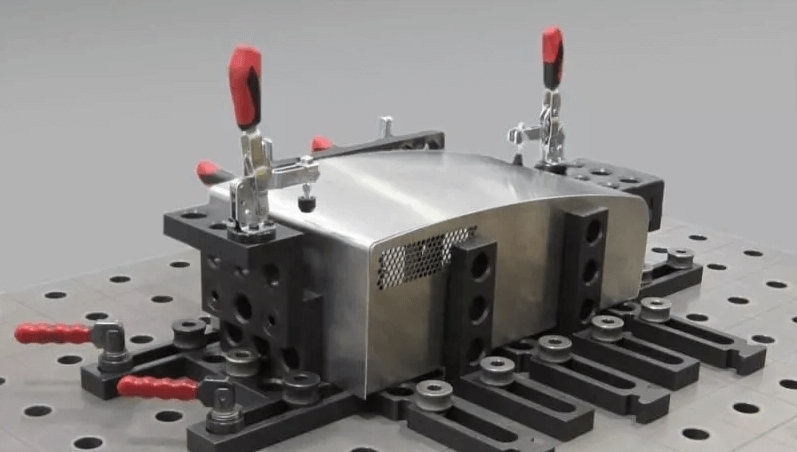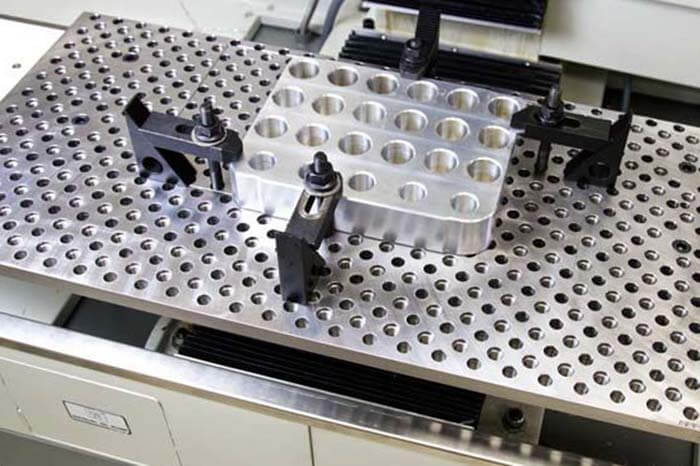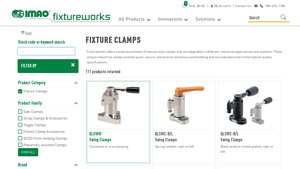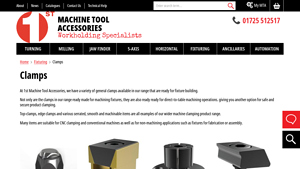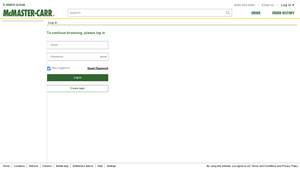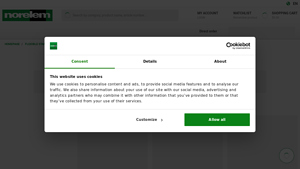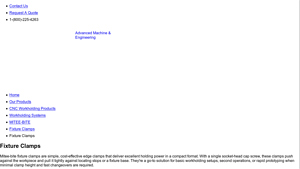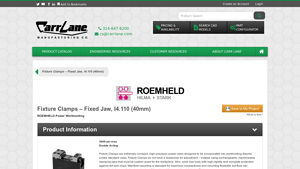Cnc Fixture Clamps Guide: Type, Cost, Top List…
Introduction: Navigating the Global Market for cnc fixture clamps
In the ever-evolving landscape of global manufacturing, sourcing CNC fixture clamps can present a formidable challenge for B2B buyers, especially those operating in diverse regions such as Africa, South America, the Middle East, and Europe. The right fixture clamps are essential for ensuring precision, efficiency, and safety in machining processes, yet navigating the myriad of options and suppliers can be daunting. This guide seeks to demystify the complexities surrounding CNC fixture clamps by offering a thorough exploration of their types, applications, and the intricacies of supplier vetting.
From quick-release clamps to pneumatic-assisted solutions, understanding the different types of CNC fixture clamps available is crucial for making informed purchasing decisions. Each type serves specific applications, whether for direct-to-table machining or complex assembly processes, thereby impacting operational efficiency and product quality. Additionally, this guide delves into cost considerations, helping buyers evaluate the total value of their investments beyond the initial price tag.
By equipping international B2B buyers with the knowledge to assess product specifications and supplier reliability, this comprehensive resource empowers them to make strategic decisions that align with their unique operational needs. Whether you’re in Brazil looking for robust clamping solutions or in Vietnam seeking innovative fixture designs, this guide will serve as an invaluable tool in your procurement journey.
Understanding cnc fixture clamps Types and Variations
| Type Name | Key Distinguishing Features | Primary B2B Applications | Brief Pros & Cons for Buyers |
|---|---|---|---|
| Toggle Clamps | Fast action, lever-operated, versatile design | General machining, assembly | Pros: Quick operation, strong holding force; Cons: Limited height adjustment. |
| Pneumatic Clamps | Air-powered, high speed, automated | High-volume production, CNC machining | Pros: Increased efficiency, consistent clamping; Cons: Requires air supply, higher initial cost. |
| Swing Clamps | Pivoting arm design, allows for easy part access | Workholding for complex shapes | Pros: Flexible positioning, space-saving; Cons: May require additional space for swing motion. |
| Strap Clamps | Adjustable strap for securing irregular shapes | Fabrication, assembly | Pros: Versatile for various shapes, low cost; Cons: Slower setup time compared to rigid clamps. |
| ID/OD Form Holding Clamps | Designed for internal/external diameters, high precision | Precision machining, automotive | Pros: Excellent for complex shapes, minimizes distortion; Cons: Specific to certain applications, may need custom setups. |
What Are Toggle Clamps and Their Key Benefits for B2B Buyers?
Toggle clamps are characterized by their lever-operated mechanism, which allows for rapid clamping and unclamping of parts. They are highly versatile and can be used in various applications, such as general machining and assembly processes. For B2B buyers, the primary considerations include the strength of the clamp and its ease of use, making them ideal for operations that require quick setup and teardown. However, they may have limited height adjustment, which can be a drawback in some scenarios.
How Do Pneumatic Clamps Enhance Efficiency in B2B Operations?
Pneumatic clamps utilize compressed air to achieve quick and consistent clamping, making them suitable for high-volume production environments. They are particularly advantageous in CNC machining where speed and reliability are critical. B2B buyers should consider the initial investment and the requirement for an air supply system, but the efficiency gains often justify the costs. Their ability to automate clamping processes significantly enhances production rates, though maintenance of the pneumatic system must be factored into operational costs.
What Makes Swing Clamps Ideal for Complex Workholding Needs?
Swing clamps feature a pivoting arm that allows for easy access to the workpiece, making them suitable for workholding in complex machining tasks. They are particularly beneficial in applications where parts need to be frequently changed or adjusted. B2B buyers appreciate their flexibility and space-saving design; however, the requirement for additional space for the swing motion can be a limitation. Proper assessment of workspace dimensions is crucial before purchase.
Why Are Strap Clamps a Cost-Effective Solution for Irregular Shapes?
Strap clamps are designed to secure irregularly shaped workpieces using an adjustable strap, making them highly versatile for fabrication and assembly tasks. They are often more affordable than rigid clamps, appealing to budget-conscious B2B buyers. However, the trade-off is that strap clamps may involve longer setup times compared to their rigid counterparts. Buyers should evaluate the trade-off between cost savings and the potential impact on workflow efficiency.
In What Situations Are ID/OD Form Holding Clamps Most Effective?
ID/OD form holding clamps are specialized fixtures designed for holding parts with internal or external diameters, ensuring high precision during machining operations. They are particularly useful in industries like automotive manufacturing, where tolerances are critical. B2B buyers need to consider the specific application requirements, as these clamps may require custom setups for optimal performance. While they excel in minimizing distortion during machining, their specificity can limit broader applicability.
Key Industrial Applications of cnc fixture clamps
| Industry/Sector | Specific Application of CNC Fixture Clamps | Value/Benefit for the Business | Key Sourcing Considerations for this Application |
|---|---|---|---|
| Aerospace | Precision component assembly | Enhanced accuracy and repeatability | Certifications for aerospace standards (e.g., AS9100), material durability, and weight considerations. |
| Automotive | Machining of engine components | Increased production efficiency | Compatibility with high-volume production, quick changeover capabilities, and robust clamping force. |
| Electronics | PCB manufacturing and assembly | Improved workflow and reduced cycle time | Customization options for unique designs, material resistance to heat and chemicals, and compact sizes. |
| Heavy Machinery | Fabrication of large metal structures | Cost-effective mass production | Heavy-duty clamping solutions, resistance to wear, and ability to handle large workpieces. |
| Medical Devices | Assembly of precision medical instruments | Compliance with strict regulatory standards | Biocompatible materials, precision engineering, and traceability for quality assurance. |
In the aerospace industry, CNC fixture clamps play a crucial role in the assembly of precision components, such as turbine blades and structural elements. These clamps ensure that parts are held securely in place during machining, which is vital for maintaining tight tolerances and achieving the required accuracy. Buyers in this sector should focus on sourcing clamps that meet specific aerospace standards, ensuring durability and lightweight properties to comply with stringent regulations.
Within the automotive sector, CNC fixture clamps are essential for the machining of engine components, transmission parts, and chassis elements. They facilitate quick setup and changeover times, significantly enhancing production efficiency. B2B buyers should prioritize clamps that offer high clamping forces and compatibility with automated systems, as well as those that can withstand the rigors of high-volume manufacturing processes.
In electronics manufacturing, CNC fixture clamps are utilized for PCB assembly and testing. These clamps help secure delicate components during soldering and assembly processes, contributing to improved workflow and reduced cycle times. Buyers should consider clamps that can be customized to fit various PCB designs, ensuring they are made from materials resistant to heat and chemicals to protect sensitive electronic parts.
For the heavy machinery industry, CNC fixture clamps are integral to the fabrication of large metal structures, such as frames and chassis. They provide robust clamping solutions that ensure stability during machining operations, leading to cost-effective mass production. International buyers should look for heavy-duty clamps that can handle large workpieces and resist wear and tear over time, as well as those that offer easy integration into existing manufacturing systems.
In the medical devices sector, CNC fixture clamps are crucial for the assembly of precision instruments such as surgical tools and diagnostic equipment. These clamps must comply with strict regulatory standards, emphasizing the need for biocompatible materials and traceability throughout the manufacturing process. Buyers should focus on sourcing clamps that guarantee precision engineering to meet the high-quality requirements of the medical field.
3 Common User Pain Points for ‘cnc fixture clamps’ & Their Solutions
Scenario 1: Clamping Inconsistencies During Production Runs
The Problem: B2B buyers often encounter significant inconsistencies in clamping when using CNC fixture clamps, particularly during extended production runs. This inconsistency can lead to variations in part quality, increased scrap rates, and delays in meeting production deadlines. Buyers may struggle with clamps that do not securely hold the workpiece, causing movement during machining, which results in dimensional inaccuracies and potential tool damage.
The Solution: To mitigate clamping inconsistencies, it is essential to invest in high-quality, precision-engineered CNC fixture clamps that are specifically designed for the materials and types of machining operations being performed. Buyers should look for clamps with adjustable features and robust locking mechanisms to ensure a secure grip on various workpiece shapes and sizes. Additionally, regularly inspecting and maintaining clamps for wear and tear can prevent unexpected failures. Implementing a standard operating procedure (SOP) for clamping setups can help ensure that all operators consistently apply the same clamping techniques, reducing variability.
Scenario 2: Difficulty in Fastening and Releasing Clamps
The Problem: Many B2B buyers face challenges with the speed and efficiency of fastening and releasing CNC fixture clamps, particularly in high-volume environments. Slow clamping processes can significantly increase cycle times, leading to inefficiencies and higher operational costs. Buyers may find that certain clamps require cumbersome adjustments or tools for tightening, which can be frustrating and time-consuming, especially in just-in-time manufacturing setups.
The Solution: To enhance the speed of fastening and releasing clamps, buyers should consider using quick-release or pneumatic-assisted clamps. These clamps are designed for rapid engagement and disengagement, allowing operators to switch between setups without wasting valuable time. When sourcing clamps, look for options that integrate ergonomic designs for ease of use, such as levers or handles that can be operated with minimal effort. Training staff on best practices for using these clamps can further streamline operations and improve overall efficiency.
Scenario 3: Compatibility Issues with Existing Equipment
The Problem: Compatibility issues between CNC fixture clamps and existing machining equipment can create significant challenges for B2B buyers. When clamps do not fit or align properly with the machine table or tooling, it can result in alignment errors, damage to both the clamp and workpiece, and operational downtime. This is particularly prevalent when trying to integrate new clamps into an established workflow without a comprehensive assessment of existing equipment.
The Solution: To avoid compatibility issues, buyers should conduct a thorough compatibility assessment before purchasing new CNC fixture clamps. This involves checking the specifications of both the clamps and the machining equipment to ensure they will work together seamlessly. It’s advisable to consult with suppliers who offer a range of clamps with various mounting options, such as T-slot or through-hole designs, which can accommodate different machine configurations. Additionally, investing in modular clamping systems can provide the flexibility needed to adapt to various machining tasks, ensuring that the clamps can be easily modified or adjusted as production needs change.
Strategic Material Selection Guide for cnc fixture clamps
What Are the Key Materials Used in CNC Fixture Clamps?
In the realm of CNC fixture clamps, the choice of material is critical to ensuring optimal performance, durability, and cost-effectiveness. Below, we analyze four common materials used in the manufacturing of CNC fixture clamps, focusing on their properties, advantages and disadvantages, and considerations for international buyers.
Steel: The Go-To Material for Strength and Durability
Key Properties: Steel is renowned for its high tensile strength and excellent wear resistance. It can withstand significant pressure and is suitable for high-temperature applications. Depending on the alloy, steel can also offer good corrosion resistance.
Pros & Cons: Steel clamps are highly durable and can endure heavy loads, making them ideal for demanding machining environments. However, they are heavier than other materials, which may complicate handling. Additionally, while carbon steel is generally cost-effective, stainless steel variants can be more expensive.
Impact on Application: Steel clamps are compatible with a wide range of media, including oils and coolants, making them versatile for various machining processes.
Considerations for International Buyers: Compliance with standards such as ASTM A36 or DIN 17100 is crucial for buyers, particularly in regions with stringent quality regulations. Buyers should also consider the availability of steel grades in their local markets, as this can affect lead times and costs.
Aluminum: Lightweight and Corrosion-Resistant
Key Properties: Aluminum is lightweight yet strong, offering good corrosion resistance and thermal conductivity. It is suitable for applications requiring frequent repositioning due to its lower weight.
Pros & Cons: The primary advantage of aluminum clamps is their ease of handling and installation, which can enhance productivity. However, they may not withstand the same high loads as steel clamps, making them less suitable for heavy-duty applications. Additionally, aluminum can be more expensive than basic steel options.
Impact on Application: Aluminum is compatible with a variety of media, but it may not be suitable for aggressive chemicals or high-temperature environments.
Considerations for International Buyers: Buyers should ensure compliance with international standards such as ASTM B221 for aluminum extrusions. In regions like Europe, understanding the differences in alloy specifications (e.g., EN AW-6060) can be critical.
Plastic: Cost-Effective and Lightweight
Key Properties: Plastic clamps are often made from high-performance polymers, offering good chemical resistance and lightweight properties. They can also be engineered for specific applications, such as high-temperature resistance.
Pros & Cons: The primary advantage of plastic clamps is their low cost and lightweight nature, which makes them easy to handle. However, they generally have lower strength compared to metal options, limiting their use in heavy-duty applications.
Impact on Application: Plastic clamps are suitable for non-metallic workpieces and environments where corrosion is a concern. They are often used in assembly applications rather than machining.
Considerations for International Buyers: Buyers should check for compliance with relevant standards such as ISO 9001 for quality management. Additionally, understanding local regulations regarding the use of plastics can be important, especially in regions with strict environmental policies.
Composite Materials: The Future of Lightweight Clamping Solutions
Key Properties: Composite materials, often made from a combination of plastics and fibers, offer unique properties such as high strength-to-weight ratios and excellent corrosion resistance.
Pros & Cons: Composites can provide significant weight savings while maintaining strength, making them ideal for applications where weight is a concern. However, they can be more expensive and may require specialized manufacturing processes.
Impact on Application: Composites are suitable for high-tech applications, including aerospace and automotive sectors, where performance is critical.
Considerations for International Buyers: Buyers should ensure that composite materials meet industry-specific standards, such as AS9100 for aerospace applications. Understanding the supply chain for composite materials in their region is also essential for timely procurement.
Summary Table of Material Properties for CNC Fixture Clamps
| Material | Typical Use Case for cnc fixture clamps | Key Advantage | Key Disadvantage/Limitation | Relative Cost (Low/Med/High) |
|---|---|---|---|---|
| Steel | Heavy-duty machining | High strength and durability | Heavier, can be more expensive | Medium |
| Aluminum | Lightweight machining and assembly | Lightweight and corrosion-resistant | Lower load capacity | Medium |
| Plastic | Non-metallic workpieces and assembly | Low cost and lightweight | Limited strength | Low |
| Composite | High-tech applications | High strength-to-weight ratio | Higher cost, specialized processing | High |
This strategic material selection guide aims to equip international B2B buyers with the necessary insights to make informed decisions when sourcing CNC fixture clamps, ensuring they choose materials that align with their operational needs and compliance requirements.
In-depth Look: Manufacturing Processes and Quality Assurance for cnc fixture clamps
What Are the Main Stages in the Manufacturing Process of CNC Fixture Clamps?
The manufacturing of CNC fixture clamps involves a series of critical stages, each essential for ensuring the final product meets industry standards and customer requirements. These stages include material preparation, forming, assembly, and finishing.
Material Preparation
The first step in the manufacturing process is selecting the appropriate materials, which typically include steel, aluminum, and sometimes specialized alloys for enhanced durability and resistance to wear. The materials are then cut to size using precision cutting techniques, such as laser cutting or waterjet cutting, which ensure high accuracy and minimal waste.
Forming Techniques
Once the materials are prepared, the next phase involves shaping them into the desired form. This can be achieved through various methods, including machining, stamping, or forging. CNC machining is particularly favored for its precision, allowing for intricate designs and tight tolerances. The forming process also may include bending and welding, particularly for more complex clamp configurations.
Assembly
The assembly stage combines individual components, such as clamps, screws, and levers, into the final product. This often involves automated assembly lines that enhance efficiency and consistency. During this phase, manufacturers may employ techniques like press-fitting and riveting to ensure strong joints. Quality checks are essential at this stage to catch any misalignments or defects.
Finishing
The final step is the finishing process, which can include surface treatments such as anodizing, powder coating, or plating to enhance corrosion resistance and aesthetic appeal. The finishing touches not only improve the durability of the clamps but also ensure that they meet customer specifications regarding surface quality and functionality.
How Is Quality Assurance Implemented in CNC Fixture Clamp Manufacturing?
Quality assurance (QA) is a crucial aspect of manufacturing CNC fixture clamps. It involves systematic processes to ensure that products meet defined standards and specifications throughout the manufacturing lifecycle.
International Standards and Certifications
Manufacturers often adhere to international quality standards such as ISO 9001, which outlines a framework for quality management systems. Compliance with these standards is critical for B2B buyers, as it signifies a commitment to quality and continuous improvement. Additionally, industry-specific certifications, such as CE marking for compliance with European safety standards or API specifications for oil and gas applications, can further enhance credibility.
Quality Control Checkpoints
To maintain high-quality standards, manufacturers implement several quality control checkpoints, including:
-
Incoming Quality Control (IQC): This initial checkpoint assesses raw materials upon arrival to ensure they meet specified standards before processing begins.
-
In-Process Quality Control (IPQC): During the manufacturing process, IPQC involves monitoring production to identify defects early. This may include measuring dimensions, checking assembly alignment, and conducting functional tests.
-
Final Quality Control (FQC): Once the clamps are fully assembled, FQC involves comprehensive testing to verify that the products meet all specifications. This can include load testing, fatigue testing, and dimensional inspections.
What Common Testing Methods Are Used for CNC Fixture Clamps?
Various testing methods are employed to ensure that CNC fixture clamps meet performance and safety standards. These methods are critical in verifying the integrity and reliability of the clamps, particularly for international buyers who may have stringent requirements.
Common Testing Techniques
– Load Testing: This method assesses the clamp’s ability to withstand specified loads without failure. It helps determine the maximum operational limits of the clamps.
-
Fatigue Testing: This involves subjecting the clamps to repeated loading and unloading cycles to evaluate their durability over time. It is particularly important for clamps used in high-cycle applications.
-
Dimensional Inspection: Using tools such as calipers and gauges, manufacturers verify that the clamps adhere to specified dimensions and tolerances. This ensures proper fit and function in the intended application.
-
Surface Quality Testing: This may include visual inspections and surface roughness measurements to ensure that the finishing process meets required standards for aesthetics and functionality.
How Can B2B Buyers Verify Supplier Quality Control?
B2B buyers should conduct thorough due diligence to verify the quality control practices of potential suppliers. This process can include several key actions:
Supplier Audits
Conducting on-site audits allows buyers to assess a supplier’s manufacturing processes, quality management systems, and compliance with relevant standards. Audits should focus on the supplier’s facilities, equipment, and workforce capabilities.
Requesting Quality Reports
Buyers can request quality assurance documentation, including inspection reports, testing results, and certifications. This documentation provides insight into the supplier’s commitment to quality and adherence to international standards.
Third-Party Inspections
Engaging third-party inspection services can provide an unbiased assessment of a supplier’s quality control processes. These services often include pre-shipment inspections, which verify that the products meet specified requirements before they are shipped.
What Are the Quality Control Nuances for International B2B Buyers?
International B2B buyers, particularly those in regions such as Africa, South America, the Middle East, and Europe, may encounter specific quality control nuances that are important to consider.
Understanding Local Regulations
Different regions may have varying regulations and standards that affect product quality. Buyers should familiarize themselves with local compliance requirements, such as safety regulations and environmental considerations.
Cultural Considerations
Cultural differences can influence communication and expectations regarding quality. Buyers should ensure clear communication with suppliers about quality requirements, testing protocols, and any specific standards that must be met.
Logistics and Supply Chain Factors
International logistics can introduce challenges related to product quality during transportation. Buyers should ensure that suppliers have robust packaging and handling procedures to minimize damage and maintain product integrity during transit.
By understanding these manufacturing processes and quality assurance practices, international B2B buyers can make informed decisions when sourcing CNC fixture clamps, ensuring they receive products that meet their performance and quality expectations.
Practical Sourcing Guide: A Step-by-Step Checklist for ‘cnc fixture clamps’
Introduction
Sourcing CNC fixture clamps is a critical process for manufacturers looking to enhance their machining efficiency and precision. This guide provides an actionable checklist to help B2B buyers navigate the complexities of procurement, ensuring that they select the right clamps for their specific needs while working with reliable suppliers.
Step 1: Define Your Technical Specifications
Before initiating the sourcing process, it’s essential to clearly outline the technical specifications of the CNC fixture clamps required for your operations. Consider factors such as the material type, size, load capacity, and clamping mechanism (e.g., pneumatic vs. manual). This step helps ensure that you find clamps tailored to your manufacturing processes, reducing the risk of costly errors later on.
Step 2: Research Supplier Options
Conduct thorough research to identify potential suppliers of CNC fixture clamps. Utilize online directories, trade shows, and industry networks to compile a list of reputable manufacturers and distributors. Pay attention to their product range, market presence, and customer reviews, which can provide insights into their reliability and quality.
Step 3: Evaluate Potential Suppliers
Before committing, it’s crucial to vet suppliers thoroughly. Request company profiles, case studies, and references from buyers in a similar industry or region. Look for suppliers who demonstrate a strong understanding of your specific needs and can provide customized solutions.
- Check Certifications: Ensure that the suppliers hold relevant certifications (e.g., ISO 9001) that signify adherence to quality management standards.
- Assess Experience: Choose suppliers with proven experience in delivering CNC fixture clamps, as this often correlates with higher product quality.
Step 4: Request Samples for Testing
Once you’ve shortlisted potential suppliers, request samples of the CNC fixture clamps for testing. This step allows you to evaluate the clamps’ performance, durability, and compatibility with your machinery. Testing samples can also help identify any potential issues before making a bulk purchase.
Step 5: Compare Pricing and Terms
After testing samples, compare pricing structures and terms of sale from different suppliers. Look beyond just the initial cost; consider factors like shipping fees, payment terms, and warranties. A more favorable price may not be advantageous if the supplier has lengthy lead times or poor customer service.
- Volume Discounts: Inquire about discounts for bulk orders, which can significantly reduce your overall costs.
- Return Policies: Understand the return policies in case the clamps do not meet your expectations.
Step 6: Finalize the Order and Establish Communication
Once you’ve selected a supplier, finalize your order and establish clear lines of communication. Confirm all details, including delivery schedules and any after-sales support. A proactive communication approach can help address any issues promptly and foster a long-term relationship with the supplier.
Step 7: Monitor Performance and Gather Feedback
After the clamps have been integrated into your operations, monitor their performance and gather feedback from your team. Continuous assessment will help identify areas for improvement and inform future sourcing decisions. Maintaining an open dialogue with your supplier can also lead to better support and potential enhancements to your clamping solutions.
By following these steps, B2B buyers can confidently source CNC fixture clamps that meet their needs while ensuring they partner with reputable suppliers.
Comprehensive Cost and Pricing Analysis for cnc fixture clamps Sourcing
What Are the Key Cost Components in CNC Fixture Clamps Sourcing?
When sourcing CNC fixture clamps, several cost components contribute to the overall pricing structure. These include materials, labor, manufacturing overhead, tooling, quality control (QC), logistics, and profit margins.
-
Materials: The choice of materials, such as steel, aluminum, or specialized alloys, significantly affects the base cost of clamps. Higher-grade materials may offer enhanced durability and performance but will also increase the upfront costs.
-
Labor: Labor costs vary by region and supplier capabilities. In regions with lower labor costs, such as certain parts of Africa or South America, buyers may benefit from reduced prices, but this may come at the expense of quality or consistency.
-
Manufacturing Overhead: This encompasses utilities, facility costs, and equipment maintenance. Efficient manufacturing processes can lower overhead and, in turn, the final price of clamps.
-
Tooling: Custom tooling for specific clamp designs can be a substantial initial investment. However, amortizing these costs over larger production runs can lead to lower unit prices.
-
Quality Control: Ensuring that clamps meet specified standards involves rigorous QC processes, which can add to costs but are essential for maintaining product reliability.
-
Logistics: Transportation and warehousing costs are critical, especially for international buyers. These costs can fluctuate based on shipping methods, distances, and local tariffs.
-
Margin: Suppliers typically include a profit margin that reflects their operational costs and market positioning. Understanding this margin can help buyers negotiate better deals.
How Do Price Influencers Affect CNC Fixture Clamps Pricing?
Several factors influence the pricing of CNC fixture clamps, and understanding these can provide a competitive edge.
-
Volume/MOQ: Minimum order quantities (MOQ) often dictate pricing. Suppliers may offer discounts for bulk orders, making it advantageous for businesses to consolidate purchases.
-
Specifications and Customization: Specialized clamps designed for unique applications may incur higher costs due to additional engineering and manufacturing efforts. Buyers should weigh the necessity of customization against the potential cost implications.
-
Materials and Quality Certifications: Higher-quality materials and certifications (such as ISO or ASTM) can significantly increase prices. Buyers should consider whether these certifications are essential for their applications.
-
Supplier Factors: The reputation and reliability of the supplier can influence pricing. Established suppliers may charge more but often provide better service and assurance of quality.
-
Incoterms: Understanding shipping terms is crucial for international buyers. Incoterms dictate who is responsible for shipping, insurance, and tariffs, which can affect the total landed cost.
What Are Effective Buyer Tips for Negotiating CNC Fixture Clamps Prices?
To secure the best pricing on CNC fixture clamps, buyers should consider the following strategies:
-
Negotiation: Engage in open discussions with suppliers about pricing, especially if you are purchasing in larger volumes. Highlighting your potential for repeat business can encourage suppliers to offer better terms.
-
Cost-Efficiency: Evaluate the total cost of ownership (TCO), which includes not just the purchase price but also maintenance, replacement, and operational costs over time. A higher initial investment in quality clamps may lead to lower TCO.
-
Pricing Nuances for International Buyers: Buyers from regions like Africa, South America, and the Middle East should be aware of potential tariffs, import duties, and currency fluctuations that can impact overall costs. It’s beneficial to work with suppliers who have experience in international trade to mitigate these issues.
-
Market Research: Conduct thorough market research to compare prices and features across different suppliers. This knowledge empowers buyers during negotiations and helps identify fair pricing.
Disclaimer on Indicative Prices
Prices for CNC fixture clamps can vary widely based on the factors mentioned above. The values provided in supplier catalogs or websites should be viewed as indicative rather than fixed. Engaging with multiple suppliers and seeking quotations tailored to specific needs will yield the most accurate and competitive pricing.
Alternatives Analysis: Comparing cnc fixture clamps With Other Solutions
Understanding Alternatives to CNC Fixture Clamps
In the realm of manufacturing and machining, CNC fixture clamps play a critical role in securing workpieces during machining operations. However, it’s essential to explore alternative solutions that can also provide effective workholding. This analysis will compare CNC fixture clamps with two viable alternatives: Magnetic Workholding Systems and Vacuum Clamping Systems. Understanding these options allows B2B buyers to make informed decisions based on their specific operational needs.
| Comparison Aspect | Cnc Fixture Clamps | Magnetic Workholding Systems | Vacuum Clamping Systems |
|---|---|---|---|
| Performance | High clamping force, suitable for various materials | Excellent for flat and ferrous materials; quick setup | Good for thin or flexible materials; strong hold on non-porous surfaces |
| Cost | Generally moderate; varies by type and brand | Moderate initial investment; potential savings on labor | Higher initial cost due to equipment needs |
| Ease of Implementation | Requires manual setup; some skill needed | Quick setup, but requires flat surfaces | Setup can be complex; may need specialized equipment |
| Maintenance | Low; periodic inspection needed | Low; minimal maintenance required | Moderate; vacuum pumps require regular checks |
| Best Use Case | Precision machining, diverse applications | High-volume production of flat parts | Woodworking, plastic sheets, and delicate components |
What Are the Benefits and Drawbacks of Magnetic Workholding Systems?
Magnetic workholding systems leverage powerful magnets to secure ferrous workpieces, making them ideal for flat materials. One of the significant advantages is the speed of setup; operators can quickly position and secure parts without complex tooling. This efficiency is beneficial for high-volume production runs. However, these systems are primarily effective for ferrous materials, limiting their versatility. Additionally, while maintenance is low, any loss of magnetic force can lead to part slippage, necessitating careful monitoring.
How Do Vacuum Clamping Systems Compare?
Vacuum clamping systems utilize suction to hold materials firmly in place, making them particularly effective for thin or flexible workpieces, such as plastics and composites. Their design allows for uniform pressure distribution, which minimizes the risk of distortion. While they can provide a strong hold on non-porous surfaces, the initial investment can be significant, given the need for vacuum pumps and specialized fixtures. Furthermore, setup complexity can be an issue; operators may require training to ensure effective use. Regular maintenance of vacuum pumps is also necessary to prevent performance degradation.
Conclusion: Which Solution Should B2B Buyers Choose?
When deciding between CNC fixture clamps, magnetic workholding systems, and vacuum clamping systems, B2B buyers should assess their specific applications, material types, and production volumes. CNC fixture clamps are ideal for precision machining across diverse materials, while magnetic systems excel in high-volume, flat part production. Conversely, vacuum systems are well-suited for delicate and non-porous materials. By considering factors such as performance, cost, ease of implementation, and maintenance, buyers can select the most suitable solution that aligns with their operational goals and budget constraints.
Essential Technical Properties and Trade Terminology for cnc fixture clamps
What Are the Key Technical Properties of CNC Fixture Clamps?
CNC fixture clamps are essential components in manufacturing processes, providing secure workholding for precision machining. Understanding their technical properties is vital for B2B buyers to make informed decisions.
1. Material Grade
The material grade of fixture clamps typically refers to the type of metal used in their construction, such as stainless steel, aluminum, or high-carbon steel. Higher-grade materials offer enhanced durability and resistance to wear and corrosion. For instance, stainless steel clamps are ideal for environments exposed to moisture, while aluminum clamps are favored for their lightweight nature. Selecting the appropriate material grade ensures longevity and reliability, thereby reducing replacement costs and downtime.
2. Holding Force
Holding force is a critical specification that indicates the maximum load a clamp can securely hold without slipping. Measured in pounds or newtons, this property directly impacts the stability of the workpiece during machining. Understanding the required holding force for specific applications helps buyers choose clamps that prevent workpiece movement, ensuring precision and quality in the final product.
3. Tolerance
Tolerance refers to the allowable deviation in dimensions of the clamps, which can significantly affect the fit and functionality. Tight tolerances are essential for high-precision applications where even minor deviations can lead to significant errors. Buyers should consider the tolerance levels required for their specific machining processes to ensure compatibility and performance.
4. Clamp Height
Clamp height is the vertical distance from the base of the clamp to its clamping surface. This specification is crucial for determining how well a clamp can accommodate various workpiece sizes and shapes. A lower clamp height may be necessary for low-profile workpieces, while adjustable clamp heights provide versatility for different applications. Selecting the right clamp height enhances accessibility and usability in machining operations.
5. Actuation Mechanism
The actuation mechanism of a clamp can vary, including manual, pneumatic, or hydraulic systems. Pneumatic clamps offer quick actuation and are suitable for high-speed operations, while hydraulic clamps provide significant force for heavy-duty applications. Understanding the actuation mechanism helps buyers select clamps that align with their operational requirements, enhancing efficiency and productivity.
What Are Common Trade Terminology and Jargon Related to CNC Fixture Clamps?
Familiarity with industry terminology is essential for effective communication and negotiation in the B2B marketplace.
1. OEM (Original Equipment Manufacturer)
OEM refers to companies that produce parts and equipment that may be marketed by another manufacturer. In the context of CNC fixture clamps, OEMs provide specialized clamps designed for specific machinery. Buyers often seek OEM clamps to ensure compatibility and quality, which can improve machine performance and reduce maintenance issues.
2. MOQ (Minimum Order Quantity)
MOQ is the smallest quantity of a product that a supplier is willing to sell. For B2B buyers, understanding MOQ is crucial for budgeting and inventory management. Suppliers may offer better pricing for larger quantities, making it advantageous for businesses with consistent production needs to negotiate favorable terms.
3. RFQ (Request for Quotation)
An RFQ is a formal process where buyers request pricing and terms from suppliers for specific products or services. Submitting an RFQ for CNC fixture clamps allows buyers to compare options and make informed purchasing decisions based on quality, price, and delivery timelines.
4. Incoterms
Incoterms are international commercial terms that define the responsibilities of buyers and sellers in shipping agreements. Familiarity with these terms helps B2B buyers understand shipping costs, risk, and responsibilities associated with transporting CNC fixture clamps, facilitating smoother transactions across borders.
5. Lead Time
Lead time refers to the time it takes from placing an order to receiving the product. Understanding lead times is essential for B2B buyers to plan production schedules and avoid delays. Suppliers with shorter lead times can provide a competitive advantage, particularly in fast-paced manufacturing environments.
By grasping these technical properties and trade terms, B2B buyers can make more strategic decisions regarding the procurement of CNC fixture clamps, ultimately enhancing their operational efficiency and product quality.
Navigating Market Dynamics and Sourcing Trends in the cnc fixture clamps Sector
What Are the Current Market Dynamics and Key Trends in the CNC Fixture Clamps Sector?
The CNC fixture clamps sector is experiencing significant transformation driven by various global factors. Rapid advancements in automation and Industry 4.0 are reshaping manufacturing processes, leading to increased demand for precision clamping solutions. B2B buyers, particularly in Africa, South America, the Middle East, and Europe, are increasingly seeking innovative clamping solutions that not only enhance productivity but also reduce setup times and improve the accuracy of machining operations.
Emerging technologies such as IoT-enabled clamping systems are becoming more prominent, allowing manufacturers to monitor and optimize clamping forces in real-time. This trend is particularly appealing to international buyers looking to enhance operational efficiency. Additionally, there is a growing emphasis on modular and adaptable clamping systems that can easily integrate with various CNC machines, providing flexibility for manufacturers dealing with diverse product lines.
Sourcing trends indicate a shift towards suppliers offering comprehensive solutions rather than just individual components. Buyers are now favoring suppliers who can provide complete clamping systems, including accessories and customization options. This approach not only streamlines procurement but also enhances compatibility and performance across different machining setups.
How Does Sustainability and Ethical Sourcing Impact B2B Buyers in the CNC Fixture Clamps Market?
Sustainability is increasingly becoming a critical consideration for B2B buyers in the CNC fixture clamps market. The environmental impact of manufacturing processes is under scrutiny, prompting companies to adopt greener practices. Buyers are now prioritizing suppliers who demonstrate a commitment to reducing their carbon footprint through sustainable manufacturing practices and materials.
Ethical sourcing is also gaining importance. B2B buyers are more inclined to partner with suppliers who ensure fair labor practices and transparency within their supply chains. Certifications such as ISO 14001 for environmental management and ISO 45001 for occupational health and safety are becoming essential criteria for supplier evaluation.
Furthermore, the use of recycled materials in the production of CNC fixture clamps is on the rise. Buyers are looking for products that incorporate sustainable materials, reducing their overall environmental impact. This shift not only aligns with corporate social responsibility goals but also appeals to a growing consumer base that values sustainability.
What Is the Brief Evolution and History of CNC Fixture Clamps?
The evolution of CNC fixture clamps can be traced back to the early days of machining, where simple mechanical clamps were employed to secure workpieces. As CNC technology advanced, the need for more sophisticated clamping solutions emerged. The introduction of pneumatic and hydraulic clamps marked a significant turning point, allowing for quicker and more efficient clamping processes.
In recent years, innovations such as quick-change systems and modular clamping solutions have revolutionized the market. These advancements have enabled manufacturers to enhance flexibility and reduce downtime, making CNC fixture clamps an integral part of modern machining operations. Today, the focus is on smart technologies and sustainable practices, shaping the future of the CNC fixture clamps sector as it continues to adapt to the needs of global B2B buyers.
Frequently Asked Questions (FAQs) for B2B Buyers of cnc fixture clamps
-
How do I select the right CNC fixture clamps for my manufacturing needs?
Choosing the right CNC fixture clamps involves understanding your specific machining operations and requirements. Consider factors like the type of workpieces you handle, the dimensions and weight of these pieces, and the precision needed during the clamping process. Evaluate different clamp types such as toggle clamps, swing clamps, or pneumatic clamps based on their application suitability. Additionally, consulting with suppliers about your production goals can provide insights into the best options for your specific setup. -
What are the advantages of using pneumatic clamping systems in CNC machining?
Pneumatic clamping systems offer several advantages, including speed, efficiency, and ease of operation. They can significantly reduce setup times by allowing rapid clamping and unclamping of workpieces, which is crucial in high-volume production environments. Additionally, pneumatic clamps provide consistent clamping force, which enhances precision and reduces the risk of workpiece damage during machining. Their adaptability to various fixture designs makes them ideal for diverse applications across different industries. -
How can I ensure the quality of CNC fixture clamps from suppliers?
To ensure quality, vet potential suppliers by checking their certifications, such as ISO 9001, which indicates adherence to quality management standards. Request samples or detailed specifications to evaluate materials and construction. Additionally, seek reviews or references from other B2B buyers to gauge supplier reliability. Implementing a quality assurance process that includes inspections upon receipt can further safeguard against defective products. -
What customization options are available for CNC fixture clamps?
Many suppliers offer customization options tailored to specific machining needs. This may include adjusting dimensions, materials, or clamping mechanisms to suit unique workpieces or production processes. Discussing your requirements with the supplier can lead to customized solutions that enhance efficiency and effectiveness in your operations. Be sure to inquire about lead times and costs associated with custom designs to plan accordingly. -
What are the typical minimum order quantities (MOQs) for CNC fixture clamps?
Minimum order quantities can vary significantly between suppliers and depend on the type of clamps you are purchasing. Standard clamps may have lower MOQs, while custom designs typically require larger orders. It’s advisable to communicate directly with suppliers to negotiate MOQs based on your specific needs and projected usage. Some suppliers may offer flexibility for first-time buyers or smaller businesses, so exploring these options can be beneficial. -
What payment terms should I expect when sourcing CNC fixture clamps internationally?
Payment terms can vary by supplier and may include options like upfront payments, net 30/60/90 days, or payment upon delivery. It’s essential to clarify these terms during negotiations to avoid misunderstandings. Consider using secure payment methods such as letters of credit or escrow services for larger transactions to mitigate risk. Understanding the currency exchange implications is also crucial, especially for international transactions. -
How do I handle logistics and shipping for CNC fixture clamps?
Effective logistics management involves selecting a reliable shipping method that aligns with your timeline and budget. Discuss shipping options with your supplier, including air freight for expedited needs or sea freight for cost-effective solutions. Ensure that all shipping documentation is in order to avoid customs delays. It’s wise to partner with a logistics provider experienced in international shipping to facilitate smoother transportation and compliance with import regulations. -
What should I consider regarding after-sales support for CNC fixture clamps?
After-sales support is critical for addressing any issues that arise post-purchase. Ensure the supplier offers comprehensive support services, including installation guidance, troubleshooting, and warranty coverage. A responsive customer service team can help with replacement parts or repairs, which can minimize downtime. Establishing a relationship with your supplier for ongoing support can enhance your operational efficiency and foster long-term collaboration.
Important Disclaimer & Terms of Use
⚠️ Important Disclaimer
The information provided in this guide, including content regarding manufacturers, technical specifications, and market analysis, is for informational and educational purposes only. It does not constitute professional procurement advice, financial advice, or legal advice.
While we have made every effort to ensure the accuracy and timeliness of the information, we are not responsible for any errors, omissions, or outdated information. Market conditions, company details, and technical standards are subject to change.
B2B buyers must conduct their own independent and thorough due diligence before making any purchasing decisions. This includes contacting suppliers directly, verifying certifications, requesting samples, and seeking professional consultation. The risk of relying on any information in this guide is borne solely by the reader.
Top 8 Cnc Fixture Clamps Manufacturers & Suppliers List
1. Fixtureworks – Workholding Clamps and Fasteners
Domain: fixtureworks.com
Registered: 2003 (22 years)
Introduction: Workholding Workpiece Clamps for Industrial Applications – Fixtureworks. Product categories include Quick Release Clamps, Ball Lock Fasteners, Pneumatic Clamping Fasteners, Toggle Clamps, Fixture Clamp Accessories, Clamping Locator Systems, Work Positioning Elements, Vises & Accessories, and Mechanical Linear Actuators. Specific types of clamps mentioned are ID/OD Form Holding Clamps, Pneumatic As…
2. 1MTA – Clamps for Fixture Building and Machining
Domain: 1mta.com
Registered: 2005 (20 years)
Introduction: Clamps available for fixture building and direct-to-table machining operations. Types include: Top-clamps, edge clamps, serrated clamps, smooth clamps, machinable clamps, low profile clamps, pulldown clamps, swing clamps, toolmakers clamps, and V-Cut clamps. Suitable for CNC clamping, conventional machines, and non-machining applications like fabrication or assembly. Specific items include: Ball E…
3. McMaster – Fixture Clamps
Domain: mcmaster.com
Registered: 1994 (31 years)
Introduction: This company, McMaster – Fixture Clamps, is a notable entity in the market. For specific product details, it is recommended to visit their website directly.
4. Norelem USA – Fixture Clamps & Screws
Domain: norelemusa.com
Registered: 2024 (1 years)
Introduction: Fixture clamps and fixture clamp screws made from steel.
5. AME – Mitee-Bite Fixture Clamps
Domain: ame.com
Registered: 1994 (31 years)
Introduction: {‘product_name’: ‘Mitee-Bite Fixture Clamps’, ‘description’: ‘Simple, cost-effective edge clamps that deliver excellent holding power in a compact format. Ideal for basic workholding setups, second operations, or rapid prototyping.’, ‘features’: [‘Simple Design – One-screw actuation for fast part changes’, ‘Compact – Maximizes machining envelope and part density’, ‘Durable Construction – Heat-trea…
6. Carr Lane – Fixture Clamps
Domain: carrlane.com
Registered: 1996 (29 years)
Introduction: Product Name: Fixture Clamps – Fixed Jaw, I4.110 (40mm)\nModel: CLR-4413-001 (Short Stroke), CLR-4413-031 (Long Stroke)\nJaw Width: 40mm\nMaximum Clamping Force: 2100 lbs (9.5 kN)\nClamping Stroke: Short Stroke – 5mm, Long Stroke – 30mm\nMax Pressure: 3600 psi\nMaterial: Steel\nClamping Action: Double Acting, hydraulic piston\nDesign: Compact, high-precision, no leadscrew for adjustment, exchangea…
7. Haas CNC – Fixture Clamps for Machining
Domain: haascnc.com
Registered: 1996 (29 years)
Introduction: Fixture clamps for machining applications, suitable for CNC and milling operations. Designed to securely hold workpieces during machining processes, enhancing precision and efficiency. Available in various sizes and configurations to accommodate different machining needs. Compatible with Haas tooling systems and can be integrated into automated workholding setups.
8. Xindian Precise – Expansion Clamps
Domain: xindianprecise.com
Registered: 2023 (2 years)
Introduction: Expansion clamps are designed for precise fixturing in various applications. They provide strong clamping force and are suitable for use in machining, assembly, and inspection processes. The clamps are made from high-quality materials to ensure durability and reliability. They feature adjustable mechanisms for versatility in different setups. Available in various sizes to accommodate different wor…
Strategic Sourcing Conclusion and Outlook for cnc fixture clamps
What Are the Key Takeaways for Strategic Sourcing of CNC Fixture Clamps?
In today’s competitive landscape, strategic sourcing of CNC fixture clamps is essential for optimizing production efficiency and reducing operational costs. Key takeaways include understanding the diverse range of clamps available—such as pneumatic, toggle, and side clamps—and their specific applications across various machining processes. By leveraging innovative clamping solutions, businesses can enhance productivity while ensuring safety and precision in their operations.
How Can International B2B Buyers Benefit from Strategic Sourcing?
International buyers from regions like Africa, South America, the Middle East, and Europe must prioritize building strong supplier relationships to secure high-quality fixtures that meet their unique operational needs. Engaging with reputable manufacturers can lead to customized solutions that improve workflow and reduce downtime. Additionally, adopting a data-driven approach to sourcing can provide insights into market trends, enabling better decision-making.
What Does the Future Hold for CNC Fixture Clamps?
Looking ahead, the demand for advanced CNC fixture clamps is expected to rise as industries embrace automation and lean manufacturing practices. Buyers should stay informed about emerging technologies and innovations in clamping systems that can further streamline their processes. Embracing these advancements will not only enhance operational efficiency but also position businesses to thrive in an evolving marketplace. Now is the time to act—evaluate your sourcing strategies and partner with trusted suppliers to ensure your production capabilities remain competitive.
